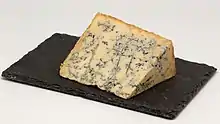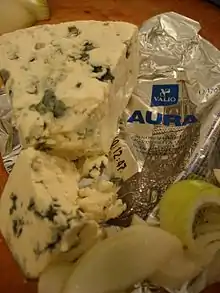Blue cheese
Blue cheese[lower-alpha 1] is any of a wide range of cheeses made with the addition of cultures of edible molds, which create blue-green spots or veins through the cheese. Blue cheeses vary in taste from very mild to strong, and from slightly sweet to salty or sharp; in colour from pale to dark; and in consistency from liquid or very soft to firm or hard. They may have a distinctive smell, either from the mold or from various specially cultivated bacteria such as Brevibacterium linens.[1]

Some blue cheeses are injected with spores before the curds form, and others have spores mixed in with the curds after they form. Blue cheeses are typically aged in temperature-controlled environments.
History
Blue cheese is believed to have been discovered by accident when cheeses were stored in caves with naturally controlled temperature and moisture levels which happened to be favorable environments for varieties of harmless mold.[2] Analysis of paleofeces sampled in the salt mines of Hallstatt (Austria) showed that miners of the Hallstatt Period (800 to 400 BC) already consumed blue cheese and beer.[3]
According to legend, one of the first blue cheeses, Roquefort, was discovered when a young boy, eating bread and ewes' milk cheese, abandoned his meal in a nearby cave after seeing a beautiful girl in the distance. When he returned months later, the mold (Penicillium roqueforti) had transformed his cheese into Roquefort.[4][5]

Gorgonzola is one of the oldest known blue cheeses, having been created around AD 879, though it is said that it did not contain blue veins until around the 11th century.[6][7] Stilton is a relatively new addition, becoming popular sometime in the early 1700s.[8] Many varieties of blue cheese originated subsequently, such as the 20th century Danablu and Cambozola, were an attempt to fill the demand for Roquefort-style cheeses.

Production
Similarly to other varieties of cheese, the process of making blue cheese consists of six standard steps. However, additional ingredients and processes are required to give this blue-veined cheese its particular properties. To begin with, the commercial scale production of blue cheese consists of two phases: the culturing of suitable spore-rich inocula and fermentation for maximum, typical flavor.[9]
Penicillium roqueforti inoculum
In the first phase of production, a Penicillium roqueforti inoculum is prepared prior to the actual production of blue cheese.[10] Multiple methods can be used to achieve this. However, all methods involve the use of a freeze-dried Penicillium roqueforti culture. Although Penicillium roqueforti can be found naturally, cheese producers nowadays use commercially manufactured Penicillium roqueforti. First, Penicillium roqueforti is washed from a pure culture agar plants which is later frozen.[10] Through the freeze drying process, water from the frozen state is evaporated without the transition through the liquid state (sublimation). This retains the value of the culture and is activated upon the addition of water.
Salt, sugar or both are added to autoclaved, homogenized milk via a sterile solution. This mixture is then inoculated with Penicillium roqueforti. This solution is first incubated for three to four days at 21–25 °C (70–77 °F). More salt and/or sugar is added and then aerobic incubation is continued for an additional one to two days.[9] Alternatively, sterilized, homogenized milk and reconstituted non-fat solids or whey solids are mixed with sterile salt to create a fermentation medium. A spore-rich Penicillium roqueforti culture is then added. Next, modified milk fat is added which consists of milk fat with calf pre-gastric esterase.[11] This solution is prepared in advance by an enzyme hydrolysis of a milk fat emulsion. The addition of modified milk fat stimulates a progressive release of free fatty acids via lipase action which is essential for rapid flavor development in blue cheese.[10] This inoculum produced by either methods is later added to the cheese curds.[10]
Production and fermentation
First, raw milk (either from cattle, goats or sheep) is mixed and pasteurized at 72 °C (162 °F) for 15 seconds.[12] Then, acidification occurs: a starter culture, such as Streptococcus lactis, is added in order to change lactose to lactic acid, thus changing the acidity of the milk and turning it from liquid to solid.[13] The next step is coagulation, where rennet, a mixture of rennin and other material found in the stomach lining of a calf is added to solidify the milk further.[13] Following this, thick curds are cut typically with a knife to encourage the release of liquid or whey.[13] The smaller the curds are cut, the thicker and harder the resulting cheese will become.[13]
After the curds have been ladled into containers in order to be drained and formed into a full wheel of cheese, the Penicillium roqueforti inoculum is sprinkled on top of the curds along with Brevibacterium linens.[13] Then, the curds granules are knit in molds to form cheese loaves with a relatively open texture.[10] Next, whey drainage continues for 10–48 hours in which no pressure is applied, but the molds are inverted frequently to promote this process.[12] Salt is then added to provide flavor as well as to act as a preservative so the cheese does not spoil through the process of brine salting or dry salting for 24–48 hours.[12] The final step is ripening the cheese by aging it. When the cheese is freshly made, there is little to no blue cheese flavor development.[10] Usually, a fermentation period of 60–90 days are needed before the flavor of the cheese is typical and acceptable for marketing.[10]
During this ripening period, the temperature and the level of humidity in the room where the cheese is aging is monitored to ensure the cheese does not spoil or lose its optimal flavor and texture.[13] In general, the ripening temperature is around eight to ten degrees Celsius with a relative humidity of 85–95%, but this may differ according to the type of blue cheese being produced.[12] At the beginning of this ripening process, the cheese loaves are punctured to create small openings to allow air to penetrate and support the rich growth of the aerobic Penicillium roqueforti cultures, thus encouraging the formation of blue veins.[13]
Throughout the ripening process, the total ketone content is constantly monitored as the distinctive flavor and aroma of blue cheese arises from methyl ketones (including 2-pentanone, 2-heptanone, and 2-nonanone)[14] which are a metabolic product of Penicillium roqueforti.[15][16] Once the specified level of total ketone production is attained, the blue cheese is sterilized at ultra high temperature/short time at 130 °C (266 °F) for four seconds.[10] This heat treatment also inactivates the Penicillium roqueforti, inhibiting further fermentation.[10]
Toxins from the production of blue cheese
Penicillium roqueforti, responsible for the greenish blue moldy aspect of blue cheese, produces several mycotoxins. While mycotoxins like roquefortine, isofumigaclavine A, mycophenolic acid and ferrichrome are present at low levels, penicillic acid and PR toxin are unstable in the cheese. Because of the instability of PR toxin and lack of optimal environmental conditions (temperature, aeration) for the production of PR toxin and roquefortine, health hazards due to Penicillium roqueforti metabolites are considerably reduced.[17] Additionally, mycotoxin contamination occurs at low levels and large quantities of cheese are rarely consumed, suggesting that hazard to human health is unlikely. [18]
Physicochemical properties
Structure
The main structure of the blue cheese comes from the aggregation of the casein. In milk, casein does not aggregate because of the outer layer of the particle, called the “hairy layer.” The hairy layer consists of κ-casein, which are strings of polypeptides that extend outward from the center of the casein micelle.[19] The entanglement of the hairy layer between casein micelles decreases the entropy of the system because it constrains the micelles, preventing them from spreading out. Curds form, however, due to the function that the enzyme, rennet, plays in removing the hairy layer in the casein micelle. Rennet is an enzyme that cleaves the κ-casein off the casein micelle, thus removing the strain that occurs when the hairy layer entangles. The casein micelles are then able to aggregate together when they collide with each other, forming the curds that can then be made into blue cheese.
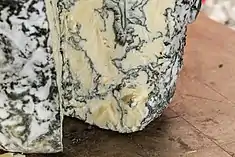
Mold growth
Penicillium roqueforti and Penicillium glaucum are both molds that require the presence of oxygen to grow. Therefore, initial fermentation of the cheese is done by lactic acid bacteria. The lactic acid bacteria, however, are killed by the low pH and the secondary fermenters, Penicillium roqueforti, take over and break the lactic acid down, maintaining a pH in the aged cheese above 6.0.[20] As the pH rises again from the loss of lactic acid, the enzymes in the molds responsible for lipolysis and proteolysis are more active and can continue to ferment the cheese because they are optimal at a pH of 6.0.[21]
Penicillium roqueforti creates the characteristic blue veins in blue cheese after the aged curds have been pierced, forming air tunnels in the cheese. When given oxygen, the mold is able to grow along the surface of the curd-air interface.[22] The veins along the blue cheese are also responsible for the aroma of blue cheese itself. In fact, one type of bacteria in blue cheese, Brevibacterium linens, is the same bacteria responsible for foot and body odor. B. linens was previously thought to give cheeses their distinct orangish pigmentation, but studies show this not to be the case and blue cheese is an example of the lack of that orange pigmentation.[23] In pressing the cheese, the curds are not tightly packed in order to allow for air gaps between them. After piercing, the mold can also grow in between the curds.

Regulation
European Union
In the European Union, many blue cheeses, such as Cabrales, Danablu, Gorgonzola, Roquefort and Blue Stilton, carry a protected designation of origin, meaning they can bear the name only if they have been made in a particular region. Similarly, individual countries have protections of their own such as France's Appellation d'Origine Contrôlée and Italy's Denominazione di Origine Protetta. Blue cheeses with no protected origin name are designated simply "blue cheese".
Canada
Under the regulation of the Canadian Food Inspection Agency, it requires manufacturers to produce blue cheese with a maximum of 47 percent moisture, and minimum of 27 percent milk fat.[25] Salt is allowed to be used as a preservative; however, the amount of the salt or combination of salts shall not exceed 200 parts per million of the milk and milk products used to make the cheese.[25] Other than that the regulation of Canadian Food Inspection Agency does not limit producers to use bacterial cultures to aid further ripening and flavoring preparations other than cheese flavoring.[25]
Properties
Gorgonzola, Stilton, and Roquefort are considered to be favored blue cheeses in many countries.[26] These cheeses all have a protected designation of origin in which they may only be called their respective name if produced a certain way in a certain location.
Gorgonzola
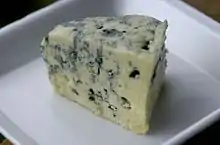
Gorgonzola blue cheese takes its name from the village of Gorgonzola in Italy where it was first made.[26] Belonging to the family of Stracchino cheeses, Gorgonzola is a whole milk, white, and "uncooked" cheese.[26] This blue cheese is inoculated with Penicillium glaucum which, during ripening, produces the characteristic of blue-green veins.[26] The odor of Gorgonzola varies between natural and creamy Gorgonzola cheese.[27][28] 63 components in natural Gorgonzola cheese and 52 components in creamy Gorgonzola cheese contribute to odor with 2-nonanone, 1-octen-3-ol, 2-heptanol, ethyl hexanoate, methylanisole and 2-heptanone being the prominent compounds for odor in both cheeses.[27][29]
Stilton
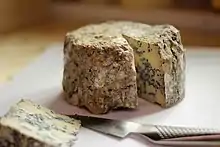
Stilton blue cheese was first sold in the village of Stilton in England but there is little evidence it was ever made there. Different from Stichelton, which is made from raw milk, Stilton cheese is made from pasteurized milk.[26] In addition to being inoculated with Penicillium roqueforti to give it the blue vein characteristic, research has shown that other microbiota which are relatives of Lactococcus lactis, Enterococcus faecalis, Lactobacillus plantarum, Lactobacillus curvatus, Leuconostoc mesenteroides, Staphylococcus equorum, and Staphylococcus sp. can also be found in Stilton cheese.[30] Some important microbiota contribute to the aromatic profile such as those of the Lactobacillus genus due to their production of volatile compounds.[31] During ripening, free fatty acids increase in amount which contribute to the characteristic flavor of blue cheeses due to fat breakdown by Penicillium roqueforti.[32]
Roquefort
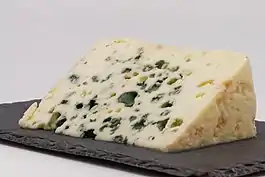
Roquefort blue cheese originates from the village of Roquefort-sur-Soulzon, France.[26] Its flavors come from the use of unpasteurized sheep's milk, inoculation with Penicillium roqueforti, and the special conditions of the natural caves of Roquefort-sur-Soulzon in which they are ripened.[26] Penicillium roqueforti is the cause of the blue veins in Roquefort cheese. In addition to Penicillium roqueforti, various yeasts are present, namely Debaryomyces hansenii and its non-sporulating form Candida famata, and Kluyveromyces lactis and its non-sporulating form Candida sphaerica.[33] Similarly to other kinds of blue cheeses, Roquefort's flavor and odor can be attributed to the particular mixture of methyl ketones such as 2-heptanone, 2-pentanone, and 2-nonanone.[14]
See also
Gallery
Notes
- sometimes bleu cheese in North American English[lower-alpha 2][lower-alpha 3]
- A common variant, using the French spelling of "blue";
- Oxford English Dictionary, updated 1972, s.v.
References
- Deetae P; Bonnarme P; Spinnler HE; Helinck S (October 2007). "Production of volatile aroma compounds by bacterial strains isolated from different surface-ripened French cheeses". Appl. Microbiol. Biotechnol. 76 (5): 1161–71. doi:10.1007/s00253-007-1095-5. PMID 17701035. S2CID 24495569.
- Cantor, M.D.; Van Den Tempel, T.; Hansen, T.K.; Ardö, Y. (1 January 2004). "Blue cheese". Cheese: Chemistry, Physics and Microbiology. 2: 175–198. doi:10.1016/S1874-558X(04)80044-7. ISBN 9780122636530. ISSN 1874-558X.
- Maixner, Frank, et al. (2021). "Hallstatt miners consumed blue cheese and beer during the Iron Age and retained a non-Westernized gut microbiome until the Baroque period". Current Biology. 31 (23): 5149–5162.e6. doi:10.1016/j.cub.2021.09.031. PMC 8660109. PMID 34648730. S2CID 238754581.
- Fabricant, Florence (23 June 1982). "Blue-veined Cheeses : The expanding choices". The New York Times. Retrieved 22 May 2010.
- "Something is rotten in Roquefort". Business Week. 31 December 2001.
- "Gorgonzola, the cheese that lives". Italian Food Excellence. 30 September 2013. Retrieved 7 August 2016.
- "Castello® Gorgonzola". Castello. Retrieved 7 August 2016.
- "History of Stilton". StiltonCheese.co.uk. Archived from the original on 7 August 2016. Retrieved 7 August 2016.
- Watts, j. C. Jr.. Nelson, J. H. (to Dairyland Food Laboratories, Inc.), U.S. Patent 3,072,488 (8 January 1963).
- Nelson, John Howard. (July 1970). "Production of Blue cheese flavor via submerged fermentation by Penicillium roqueforti". Journal of Agricultural and Food Chemistry. 18 (4): 567–569. doi:10.1021/jf60170a024.
- Nelson, J.H.; Jensen, R.G.; Pitas, R.E. (March 1977). "Pregastric Esterase and other Oral Lipases—A Review". Journal of Dairy Science. 60 (3): 327–362. doi:10.3168/jds.S0022-0302(77)83873-3. PMID 321489.
- Cantor, M. D.; van den Tempel, T.; Hansen, T. K.; Ardö, Y. (2004). "Blue cheese". Cheese: Chemistry, Physics and Microbiology. Vol. 2. Academic Press. pp. 175–198. doi:10.1016/S1874-558X(04)80044-7. ISBN 9780122636530.
- "What Makes Blue Cheese Blue?". The Spruce. Archived from the original on 14 January 2017. Retrieved 13 November 2017.
- Patton, Stuart (September 1950). "The Methyl Ketones of Blue Cheese and their Relation to its Flavor". Journal of Dairy Science. 33 (9): 680–684. doi:10.3168/jds.S0022-0302(50)91954-0.
- "Methyl ketones : Butter". webexhibits.org..
- Harte, Bruce R.; Stine, C.M. (August 1977). "Effects of Process Parameters on Formation of Volatile Acids and Free Fatty Acids in Quick-Ripened Blue Cheese". Journal of Dairy Science. 60 (8): 1266–1272. doi:10.3168/jds.S0022-0302(77)84021-6.
- Medina, Margarita; Gaya, Pilar; Nuñez, M. (February 1985). "Production of PR Toxin and Roquefortine by Penicillium roqueforti Isolates from Cabrales Blue Cheese". Journal of Food Protection. 48 (2): 118–121. doi:10.4315/0362-028X-48.2.118. PMID 30934519.
- Dobson, Alan D. W. (2017). "Mycotoxins in Cheese". Cheese (4th ed.). Academic Press. pp. 595–601. doi:10.1016/B978-0-12-417012-4.00023-5. ISBN 978-0-12-417012-4.
- Shukla, Anuj; Narayanan, Theyencheri; Zanchi, Drazen (2009). "Structure of casein micelles and their complexation with tannins". Soft Matter. 5 (15): 2884. Bibcode:2009SMat....5.2884S. doi:10.1039/b903103k. Retrieved 17 December 2017.
- Diezhandino; Fernandez; Gonzalez; McSweeney; Fresno (2015). "Microbiological, physio-chemical and proteolytic changes in a Spanish blue cheese during ripening (Valdeon cheese)". Food Chemistry. 168 (1): 134–141. doi:10.1016/j.foodchem.2014.07.039. PMID 25172692.
- Gilliot; Jany; Poirier; Maillard; Debaets; Thierry; Coton; Coton (2017). "Functional diversity within the Penicillium roqueforti species". International Journal of Food Microbiology. 241 (1): 141–150. doi:10.1016/j.ijfoodmicro.2016.10.001. PMID 27771579.
- Fernandez-salguero (2004). "INTERNAL MOULD - RIPENED CHEESES: CHARACTERISTICS, COMPOSITION AND PROTEOLYSIS OF THE MAIN EUROPEAN BLUE VEIN VARIETIES". Italian Journal of Food Science. 16 (4).
- Wolfe, Benjamin (27 July 2014). "digesting the science of fermented foods". microbialfoods.org. Retrieved 27 July 2014.
- Polowsky, Pat. "Blue". cheesescience.org.
- Branch, Legislative Services (17 June 2019). "Consolidated federal laws of canada, Food and Drug Regulations". laws-lois.justice.gc.ca. Retrieved 5 August 2019.
- Davidson, Alan; Jaine, Tom (2014). The Oxford Companion to Food (3 ed.). Oxford University Press. ISBN 9780199677337.
- Addeo, Francesco; Piombino, Paola; Moio, Luigi (May 2000). "Odour-impact compounds of Gorgonzola cheese". Journal of Dairy Research. 67 (2): 273–285. doi:10.1017/S0022029900004106. ISSN 1469-7629. PMID 10840681.
- Moio, Luigi; Piombino, Paola; Addeo, Francesco (1 May 2000). "Odour-impact compounds of Gorgonzola cheese". Journal of Dairy Research. 67 (2): 273–285. doi:10.1017/S0022029900004106. PMID 10840681.
- Monti, Lucia; Pelizzola, Valeria; Povolo, Milena; Fontana, Stefano; Contarini, Giovanna (August 2019). "Study on the sugar content of blue-veined 'Gorgonzola' PDO cheese". International Dairy Journal. 95: 1–5. doi:10.1016/j.idairyj.2019.03.009. S2CID 133493530.
- Ercolini, D.; Hill, P. J.; Dodd, C. E. R. (1 June 2003). "Bacterial Community Structure and Location in Stilton Cheese". Applied and Environmental Microbiology. 69 (6): 3540–3548. Bibcode:2003ApEnM..69.3540E. doi:10.1128/AEM.69.6.3540-3548.2003. PMC 161494. PMID 12788761.
- Mugampoza, Diriisa; Gkatzionis, Konstantinos; Linforth, Robert S.T.; Dodd, Christine E.R. (July 2019). "Acid production, growth kinetics and aroma profiles of Lactobacillus flora from Stilton cheese". Food Chemistry. 287: 222–231. doi:10.1016/j.foodchem.2019.02.082. PMID 30857693. S2CID 75135576.
- Madkor, S.; Fox, P.F.; Shalabi, S.I.; Metwalli, N.H. (January 1987). "Studies on the ripening of stilton cheese: Lipolysis". Food Chemistry. 25 (2): 93–109. doi:10.1016/0308-8146(87)90058-6.
- Besançon, X.; Smet, C.; Chabalier, C.; Rivemale, M.; Reverbel, J.P.; Ratomahenina, R.; Galzy, P. (September 1992). "Study of surface yeast flora of Roquefort cheese". International Journal of Food Microbiology. 17 (1): 9–18. doi:10.1016/0168-1605(92)90014-T. PMID 1476870.



